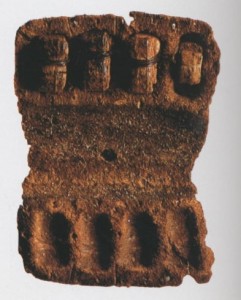Destruction of Qumran
The Dead Sea sect had expected the Roman invasion of the Land of Israel to lead to the great eschatological battle which would usher in the messianic period. Instead, the Romans easily conquered the divided Hasmonean state in 63 BCE. When the Roman revolt began in 66 CE, Josephus reports that the Essenes joined in the revolt. Even if the Qumran sect is not identical to the Essenes, it is probable that the sectarians would have joined the rebellion as well, given their messianic expectations.
In 68 CE, Qumran fell to the Romans and the sect ceased to exist. Archaeological remains show that Qumran was burnt to the ground. Whether the inhabitants were killed or captured is unknown, but, in any case, with the great destruction of the land and the people, all sectarian groups faded from view.
Throughout the period of occupation at Qumran, manuscripts had been stored in Cave 4 for regular use. As the war neared Qumran, the sectarians hid other manuscripts in caves around the area. Contrary to early claims, it is now known that the Romans did not damage the Cave 4 scrolls. Rather, the manuscripts remained hidden from the Romans and only the ravages of time and nature nearly destroyed them.
For more on the destruction of Qumran, see Schiffman, Reclaiming the Dead Sea Scrolls, p.395-397 and VanderKam and Flint, The Meaning of the Dead Sea Scrolls, p.41. Also, watch this short video:


Josephus mentions one person joining the revolt, a person who is called, in some English translations, John the Essene. But another possibility may be worth considering. Following an
observation by E. Schuerer, Abraham Schalit (in Namenwoerterbuch zu
Flavius Josephus, supp. to the Concordance edited by K.H. Rengstorf,
Leiden, 1968, p.34, 46, 66) noted that Essa appears in Josephus as a
variant reading for Gerasa, which, Schalit suggests, *may* indicate that
John was not an Essene group member, but merely someone from Gerasa.
“Vielleicht ist Essaios in B 2.567 als Ethnikon zu verstehen und mit
Gerasenos identisch (vgl. Essa A 13.393 = 1 Gerasa). Dann waere 4
Johannes kein Essener gewesen!” (46)
Philo, Josephus, and Pliny present Essenes as peaceful. A proposed
contraindication in Josephus comes in his mention of John “the Essene.”
John may have been a former Essene and been given
this atypical identification to distinguish him from others with a
common name by noting his past, differing from most revolt participants.
For example, people from Texas are rarely nicknamed “Tex” while still in
Texas. Simon “the Zealot” in Luke/Acts may be another example of this
type of naming.
At any rate the Greek for “John the Essene” differs from that for
Judah, Menahem, and Simon, who are identified as Essenes, but with
somewhat different language.
The fact that coins have been found dated 68 CE does not prove that Qumran was destroyed by the romans on that date.
It may be that Essenes fled East (perhaps as happened earlier, to the “Land of Damascus”)–Epiphanius later located torah-observing Ossenes East of the Jordan and dead Sea–before Qumran was taken by Zealots before the Romans arrived.
The so-called Yahad ostracon may not be dated from the era of the liberation of Jerusalen–Ada Yardeni dates it earlier,–but from an earlier era or from the year in the initiation process. Essenes may have liked the overthrow of the Romans but may not have been encouraged by the zealots who controlled the Temple.
All the references to Essenes in Josephus are in texts which have clearly been interterpolated. The texts appear out of the blue.
The references to Essenes in Philo are also highly suspect. “Our lawgiver trained an innumerable body of his pupils to partake in those things who are called Essenes, being, as I imagine, honoured with this appellation because of their exceeding holiness.” (Hypothetica 11.1) We have derived this and other text through the later filter of Eusebius. Clearly “our lawgiver” refers to Moses. And his pupils were the prophets, not Essenes.
One has to believe the texts attributed to both Philo and Josephus have been interfered with.